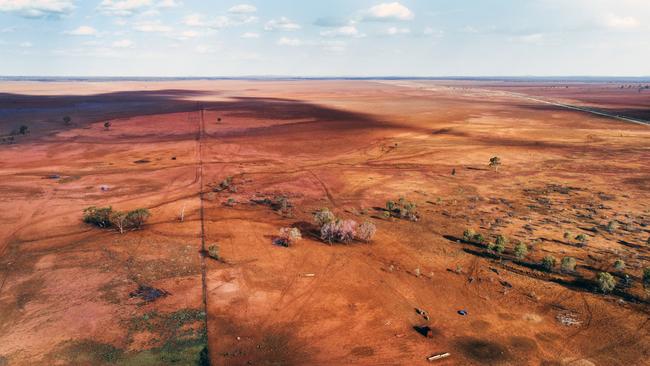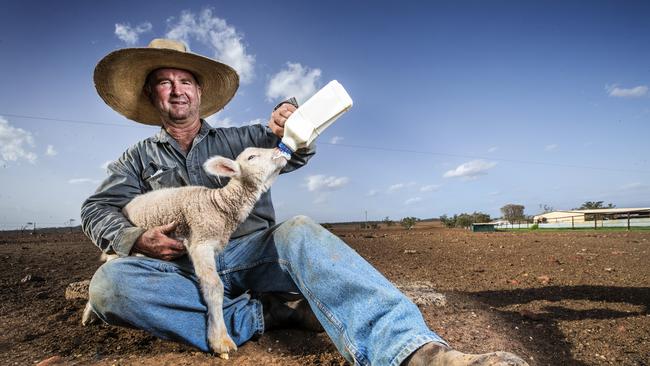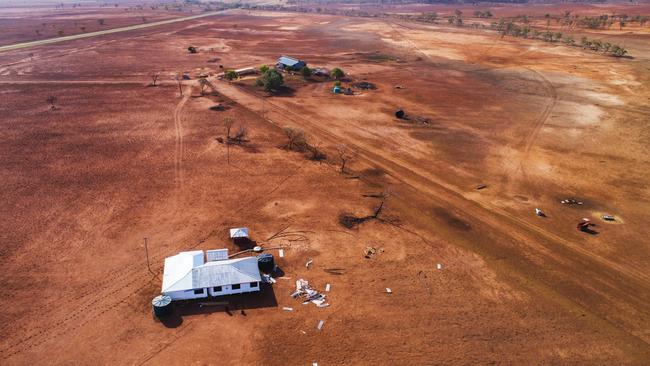Back the Bush: ‘Don’t leave us high and dry’
The Courier-Mail today begins a series highlighting the devastating impact of the drought and the everyday heroes who are determined to stay on the land. As Christmas approaches, these are the practical steps you can take to help out.
QLD News
Don't miss out on the headlines from QLD News. Followed categories will be added to My News.
QUEENSLAND’S south-east has been consumed by the worst drought in more than a century as crops fail, herds diminish, confidence falters and districts are drained of populations as desperate residents abandon the bush in search of work.
While politicians in Canberra bicker, in the state’s far-flung corners, sporting teams stop fielding players as families leave town, small businesses are boarded up on main streets, a council offers free showers to people who have no water at home and a grain farmer tells a harvesting crew to shut down because the low crop yield doesn’t justify the cost of the harvest.
SCROLL DOWN TO FIND OUT WHAT YOU CAN DO TO HELP OUT
Livestock herds dwindle, relationships break down, someone cancels a dental appointment because they know they can’t afford the bill and an elderly farmer outside Stanthorpe stops buying crucial medication at the local pharmacy, telling himself that he’ll resume taking his pills “when the rain comes’’.

Out at tiny Eromanga, the town further from the sea than any other in this dry continent, an ambitious young couple making a good living out of kangaroo shooting are suddenly living apart because the roos have disappeared with the grass, and they’re forced to work hundreds of kilometres apart.
Yet amid the growing anxiety, even as the November storms fail to materialise and the eastern states are ablaze with bushfires, the resilience of regional Queenslanders has never appeared stronger.
Pushed to the wall, primary producers, business owners, labourers and local government politicians still draw strength from their own history, remembering the hardships of those who pioneered the isolated western districts, and remaining stoic in their determination to stay put and tough it out.
The Courier-Mail is today launching a series telling the stories of the drought and calling on Queenslanders to do their bit to “Back The Bush” through small actions that can have a big impact on those ravaged by drought.
As well as shining a light on the little-told stories of our regional battlers, the series will highlight the things readers can do to help those doing it tough at ground zero.
And the reality of many lives lived at the centre of this drought is deeply troubling.
Across the Granite Belt, there are people living on large blocks of land – who do not qualify for federal drought assistance because they are not officially farmers – now struggling to pay about $300 for a truckload of water.
In Stanthorpe, the Uniting Church’s Reverend Kaye Ronalds, working closely with her community, hears of people cancelling dental visits, ignoring a GP’s referral to a specialist and declining to continue with a crucial line of medication because they simply cannot afford it “until the rain comes’’.
She also knows of extraordinary acts of generosity.
When charities manage to put some cash into the hands of a desperate farming family, that family will often immediately pass the money on to a worker they had to lay off because of drought.
“They think, ‘well instead of spending the money on getting my toenails painted red or something, I will pass it on to so-and-so who we had to let go because of the drought, because they will need this money more than we do’,’’ she said.
In a region where 70 per cent of people have a religious affiliation, Rev Ronalds also knows some parishioners are experiencing genuine despair, asking themselves the big questions about life, including the “fist shaking at the heavens’’ accompanied by the question “why me, Lord?’’
Yet blunt-talking wool grower Will Roberts – working on his sprawling Victoria Downs Station 90km east of Charleville, in his family since World War I – echoes the stoic outlook of those who have faced down hardship without giving into despair.

Mr Roberts is firing up heavy earth-moving equipme nt to build dams, pulling a cutter bar behind a bulldozer to break open the hard-baked land in preparation for rain and monitoring that dog fence which has provided some reason for optimism as his lamb tagging rates increase. “Out here you don’t wait for the rain to fall, you get the place ready for when it does,’’ he says.
Yet the challenge faced by Mr Roberts and every primary producer across a sprawling precinct, taking in every shire below the Tropic of Capricorn, is starkly illustrated in the Queensland Agriculture Department’s drought map.
Almost 70 per cent of the state is drought-declared, with the angry red swath depicting drought causing real devastation across the southeast, including shires such as Balonne, Paroo, Bulloo, Quilpie Murweh and Maranoa.
Every man, woman and child in these shires bears some of the impact of drought, but it is the primary producers who are in the front trenches.

The Australian Bureau of Agricultural and Resource Economics and Sciences (ABARES) has forecast production in the year’s last quarter at 60 per cent lower than the 10-year average, while the ongoing low rainfall predicted into January is expected to further sap the soil of moisture in cropping regions. In the more heavily populated Southern Downs Shire around Stanthorpe, Mayor Tracy Dobie is maintaining an extraordinarily calm and competent veneer as she steers her community through its worst drought crisis, probably since the 1880s.
The Granite Belt town, about to lose its water supply as Storm King Dam dries up, has been reduced to offering free showers to residents who can’t maintain personal hygiene because of lack of water.
Water trucks will begin coming to Stanthorpe from Warwick this week, in what will be a pivotal and troubling date in the evolution of this drought. Yet Cr Dobie insists that the locals are meeting the challenge with courage and determination.
Thousands of Queensland primary producers, with collective memories of drought across up to five generations, still see a future in which Queensland farmers will still play a crucial role.
Mr Roberts, pointing to the relics of his ancestors dotting his property, including a beautifully crafted, century-old shed, knows times were far tougher when the pioneers were clearing land to kick off this vital backbone industry.
“I think they might have done it tougher than us,’’ Mr Roberts said.
HOW YOU CAN BACK THE BUSH
GO VISIT
Towns in drought-hit Queensland would love to see you. Take the family to a local event. Have a counter meal at a local pub.
Stay overnight at a local B+B.
Dalby
Head west out of Brisbane through Ipswich, Gatton and Toowoomba to the historic township of Dalby. It’s only 2½ hours west of the capital and, like so many country towns, is full of tales from Queensland’s past.
The annual Dalby Stock Horse Sale is one of the biggest in Australia, and is on November 29 to December 1. Other big local events include the Dalby Show in April and Picnic Races in May.
Charleville
Continue along the Warrego to Charleville – Australia’s bilby capital. Catch a show featuring the iconic, yet endangered Aussie marsupial when in town, and don’t miss the Charleville Cosmos Centre and Observatory for an amazing outback night sky experience. Discover what the US Air Force was doing in town at the World War II Top Secret Tour, and drop in to the Royal Flying Doctor Service visitor centre to learn more about the vital outback medical service.
Quilpie
Two hours west of Charleville is the pioneering town of Quilpie – a great spot for a fish and swim at the local memorial pool. Start your journey at the local Visitor Information Centre, Museum and Gallery, which includes the Shire Museum, Military History Museum, Rail Museum and Regional Gallery. Drop into the Imperial Hotel for a feed – we hear the chicken parmies are a winner.
More events and info outbackqueensland.com.au
LEND A HAND
Have you got a trade or skill that could help a farmer or business owner in the bush?
Why not volunteer with one of the charities helping drought-affected Queensland communities.
Outback Links
Connects volunteers with people in the bush to help with property maintenance, gardening, painting and general farm support.
Rural Aid
Runs a range of volunteering opportunities, including in its Brisbane office, as a CARE Volunteer in regional and rural towns, as a member of the Farm Army, or by running a corporate volunteering day.
Aussie Helpers
Rallies volunteers for community fundraisers and food drives, and is launching its “Make a Farmer’s Christmas Special’’ campaign today to provide food and financial hampers for farmers in Queensland, NSW and Victoria.
DONATE
IGA recently launched its drought appeal across 1400 stores spread throughout Australia.


